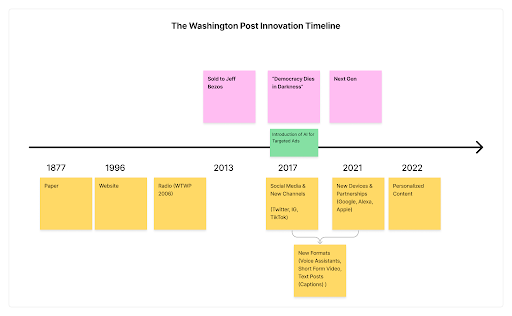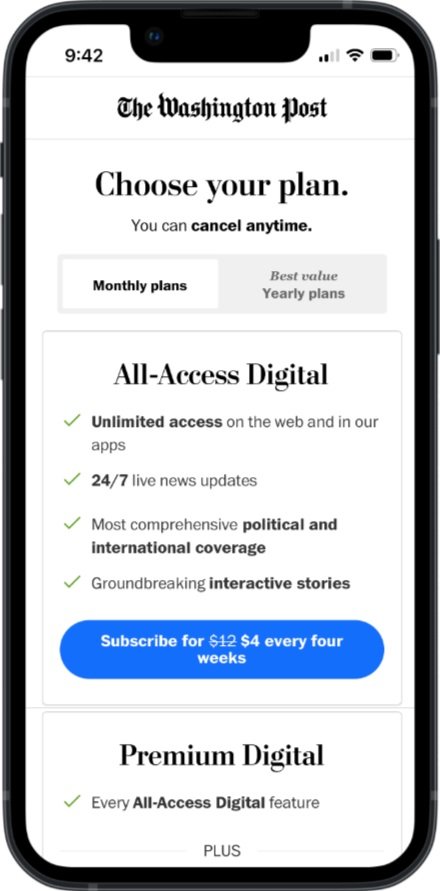The Washington Post (Concept)
Building Trustworthiness in Navigation Design
Role: UX Researcher
Team: Christine Lee
Timeline: 3 Weeks
Scope:
User Research
Heuristic Analysis
Information Architecture
UX Design
As part of my capstone project for the UCLA Extension UX IV course, I focused on user perceptions and user acquisition of the Washington Post.
We began by familiarizing ourselves with The Washington Post; gathering background information from “Digital Transformation at The Washington Post: Innovating for the Next Generation”, a publication by the University of Virginia’s McIntire School of Commerce.
“Democracy Dies in Darkness”
Since its inception in 1877, the Washington Post has aimed to provide readers with truthful and courageous journalism.
It has undergone a major transformation over the years chasing innovation and shifted in response to industry disruption caused by the internet and new state of publishing.
After an acquisition by Jeff Bezos in 2016, the Washington Post adopted a digital product mindset, changing news reporting from a technological and business standpoint.
The Gen Z Strategy
With the digital product mindset grew a new standard of constant innovation. The Washington Post continuously adapts for new opportunities and audiences.
The Next Gen initiative
A strategic roadmap for emerging audiences
Organizational transformation
Offering new products, practices and partnerships
Young readers consume content in new formats and platforms
Goals
Expanding the subscription base and reaching readers
Desk Research & Context
From my desk research, I was able to conclude that
14% of Gen Z adults reported using TikTok to start researching a major news event, significantly higher than the share of all adults (2%) saying the same.
To boost Gen Zers becoming paying subscribers, news publishers must distribute more compelling content that lives outside of their own websites.
Fake news and a general decline in trust are a constant threat
Users are suffering from subscription fatigue
Desk research revealed that although social was the main source of news consumption.. News in social was also the least trustworthy.
In order to increase user conversion and subscriptions, I had to tackle the value proposition.
What does The Post provide in value and service?
In order to acquire new subscriptions the quality of the digital product must be at the forefront of our focus.
Fake News as a threat
The Business Model Canvas - Publishing presented key jobs to be done in order to increase subscriptions
Subscribers need
Trustworthy sources
Accessibility for timely omnichannel delivery
Quality fact based objective reporting
Problem & HMW Statement
Problem Statement
As a Gen Z user, I need a way to find quality news so that I can feel confident in my perceptions and opinions.
HMW Statement
How might we increase the trustworthiness of the Washington Post for Gen Z audiences?
Secondary Research - Qualitative Interviews
Planning
Initially, I anticipated that I would host my questionnaire as a Google form and post it in social media channels such as Reddit and FB Groups.
In order to get more in depth insights, I determined that I had to transition to in person interviews.
Public Library vs. Shopping Mall
I budgeted for my study and offered participants $10 in exchange for a 10 minute interview.
I created a guide with the following questions:
What is your age?
What’s a recent piece of news that you learned about? Did it impact you directly?
Did technology play a role in you learning about this news?
Tell me more about how you hear about this piece of news?
What did you do when you heard about this news?
Did you believe this news? Why or Why not?
Did you do any research to learn more about this piece of news?
Did you communicate with anyone about this subject (virtually, in person, on the phone)?
What makes you feel qualified to tell someone about what you learned?
Recruitment Process
As I approached strangers asking them their ages, I had to reevaluate my interview process since most of my participants turned out to be minors. While I did try to keep a level of confidentiality such as not asking identifying information such as names or locations, the public surroundings did make me rethink my research process.
Was a verbal agreement enough?
Did I need a form to be signed?
Would a signature from a minor even qualify?
With the presence of a parent/guardian, would this affect my study results?
I conducted 9 qualitative interviews with Gen Z participants ranging from ages 14-26.
Research Synthesis
I recorded all my interviews and then transcribed them into notes. I used excel to organize this qualitative data
Next, I used Mural to cluster data from my interviews. This allowed me to find patterns and visualize the responses. This led me to form the key insights and takeaways.
Key Insights
The research led me to some insights about the Gen Z audience:
1. They value privacy
Generally avoid comments and fear public backlash or criticism
Not inclined to engage with other users online
2. They access traditional news through passive exposure
Viewing tv broadcast with their family
Being presented with news articles in school. Access news articles for school assignments.
Rely on suggestions and content feed
3. Local news is not real news
“Nobody talks about what’s happening on the local news. It’s not as important”
For “real news” stories, they use internet searches to gain more perspective from multiple sources
I compiled my takeaways and qualitative data from user interviews to paint a picture of the Gen Z user.
Empathy Mapping helped me understand their
Worldview
Habits
Fears
Goals
4. Their interests
Social issues that directly impact them: school shootings, gender and identity
Hobbies:video games, media and technology
Economic issues: international politics and wars
5. First hand accounts are high quality sources
Enjoy seeing first hand video with minimal editing
Follow certain creators with whom they identify and connect with
Often share content when they are emotionally invested in the subject
I created a Gen Z News Consumption journey map. This led me to look into solutions that are site wide for mobile and desktop browsing
Ideation
Analogies Ideation
Analogies Ideation allowed me to gain a fresh perspective of the problem.
How do I know if the apple is good to eat?
I’ve heard “an apple a day keeps the doctor away”
It looks shiny and new, I can’t see any bruise marks or worm holes
I’ll just hold it and feel if it is firm or soft
Lack of dirt means it was picked directly from the tree and did not touch the dirty ground
It has a green leaf on it so it seems fresh
My friend already ate a different apple from the same bowl
I can take a bite and if I don’t like it I’ll throw it away
I don’t care, I’m just hungry
Inspiration: It looks shiny and new, I can’t see any bruise marks or worm holes
Solution: Clear Presentation through accurate labeling and nomenclature
Inspiration: I can take a bite and if I don’t like it I’ll throw it away
Solution: Increase access points to prevent users to be locked into a flow
TOPICS OF INTEREST
What is Quality?
Based on Evidence
Links to reference materials
Inclusion of video content
Sources and Accountability
Keeping Authors in mind
Value Alignment
Offering relevant content that impacts Gen Z audiences directly
What is Trustworthiness?
According to Nielsen Norman Group there are 4 ways to communicate trustworthiness in design
Design Quality
Up Front Disclosure
Comprehensive and current content
Connection to the rest of the Web
Design Challenges
1. Increasing Design Quality
Observations and Insights:
In conducting a heuristic analysis, I found that the Post has many issues related to nomenclature and taxonomy.
The current organization of the site can contribute to its lack of trustworthiness.
Evidence:
Gen Z users rely heavily on search to find information because it saves them time and presents the most relevant results
Too many categories and weak nomenclature slows navigation, increasing frustration and decreasing trust
Solution:
Simplify the nomenclature to be distinct and succinct
Build structure and hierarchy with headings and icons
Global Navigation will reflect subjects and topics
Hamburger Menu reflects content types
Move the search bar to the global nav and increase navigation by decreasing number of clicks needed for access
2. Improving Upfront Disclosure
Observations and Insights:
When clicking on “The Washington Post” in the search results, the homepage immediately suggests a choose your plan. The Washington Post attempted to present the users with many options, but it is disadvantageous to imply that users should decide so early in their visits.
Evidence:
“Major news sources just want our money and they are all fighting each other for views”
“I don’t need an account to read the things I want to read”
I then decided to take another route to the site. I returned to the Google search and scrolled down for article recommendations. When I clicked on a specific article, I was given the option to read for free in exchange for creating an account.
We need to make sure that our services and offerings are equally accessible to build trust with our users.
The option to access an article for free should always be available.
Solution: Allow users to access free articles each time they revisit the site after a specific amount of time has passed.
Build trust over multiple visits
Allow users to explore The Post while conveying value through premium features
Left: User sees paywall
Right: User has the option to read for free
Testing
Additional surveys can be used to gauge user content preferences and determine hierarchy and visual placement.
Open card sorting can reveal which pages belong under each section and reveal how categories are interpreted by users. This will serve to validate the nomenclature and taxonomy choices in my new information architecture structure.
Think aloud testing with interactive prototypes can reveal issues in user acquisition flows and reveal user sentiments towards the site experience.
Additional Topics to explore & Next Steps
Connection to the Rest of the Web
Observation and Insights:
In order to communicate unbiased reporting, Gen Z would like to see more external links and sources.
Evidence:
7/9 interview participants mentioned the importances of links to sources and reference materials.
Recommendations:
Make sure to include clear hyperlinks within articles
Include a “Related Stories” section
Comprehensive and Current Content
Observation and Insights:
Returning to the Google search, scrolling down, we found some suggested stories from the Washington Post. The first suggested piece of news was an opinion piece.
Evidence:
Gen Z interview participants mentioned a general distaste for opinions that do not match their own and are aware of “fear mongering” tactics.
Recommendations:
In order to communicate the Post’s commitment to quality journalism, this is an SEO issue to tackle. Opinion pieces should not be at the forefront of search results unless the keywords match the search query.















